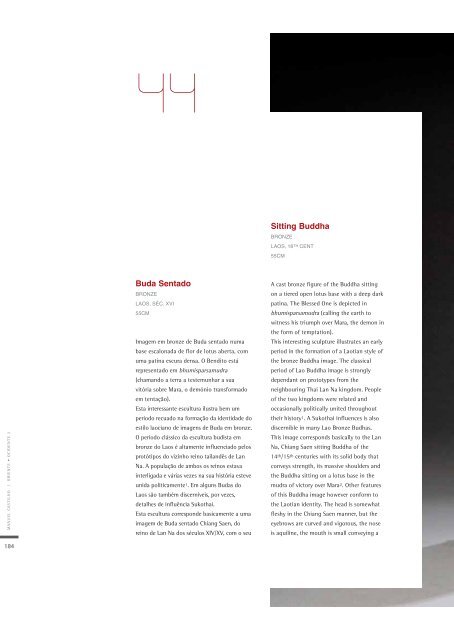ORIENTE OCIDENTE - Manuel Castilho Antiguidades
ORIENTE OCIDENTE - Manuel Castilho Antiguidades
ORIENTE OCIDENTE - Manuel Castilho Antiguidades
Create successful ePaper yourself
Turn your PDF publications into a flip-book with our unique Google optimized e-Paper software.
MANUEL CASTILHO | <strong>ORIENTE</strong> • <strong>OCIDENTE</strong> 2<br />
184<br />
44<br />
Buda Sentado<br />
BRONZE<br />
LAOS, SÉC. XVI<br />
55CM<br />
Imagem em bronze de Buda sentado numa<br />
base escalonada de flor de lotus aberta, com<br />
uma patina escura densa. O Bendito está<br />
representado em bhumisparsamudra<br />
(chamando a terra a testemunhar a sua<br />
vitória sobre Mara, o demónio transformado<br />
em tentação).<br />
Esta interessante escultura ilustra bem um<br />
período recuado na formação da identidade do<br />
estilo laociano de imagens de Buda em bronze.<br />
O período clássico da escultura budista em<br />
bronze do Laos é altamente influenciado pelos<br />
protótipos do vizinho reino tailandês de Lan<br />
Na. A população de ambos os reinos estava<br />
interligada e várias vezes na sua história esteve<br />
unida politicamente1. Em alguns Budas do<br />
Laos são também discerníveis, por vezes,<br />
detalhes de influência Sukothai.<br />
Esta escultura corresponde basicamente a uma<br />
imagem de Buda sentado Chiang Saen, do<br />
reino de Lan Na dos séculos XIV/XV, com o seu<br />
Sitting Buddha<br />
BRONZE<br />
LAOS, 16TH CENT<br />
55CM<br />
A cast bronze figure of the Buddha sitting<br />
on a tiered open lotus base with a deep dark<br />
patina. The Blessed One is depicted in<br />
bhumisparsamudra (calling the earth to<br />
witness his triumph over Mara, the demon in<br />
the form of temptation).<br />
This interesting sculpture illustrates an early<br />
period in the formation of a Laotian style of<br />
the bronze Buddha image. The classical<br />
period of Lao Buddha image is strongly<br />
dependant on prototypes from the<br />
neighbouring Thai Lan Na kingdom. People<br />
of the two kingdoms were related and<br />
occasionally politically united throughout<br />
their history1. A Sukothai influences is also<br />
discernible in many Lao Bronze Budhas.<br />
This image corresponds basically to the Lan<br />
Na, Chiang Saen sitting Buddha of the<br />
14th/15th centuries with its solid body that<br />
conveys strength, its massive shoulders and<br />
the Buddha sitting on a lotus base in the<br />
mudra of victory over Mara2. Other features<br />
of this Buddha image however conform to<br />
the Laotian identity. The head is somewhat<br />
fleshy in the Chiang Saen manner, but the<br />
eyebrows are curved and vigorous, the nose<br />
is aquiline, the mouth is small conveying a


